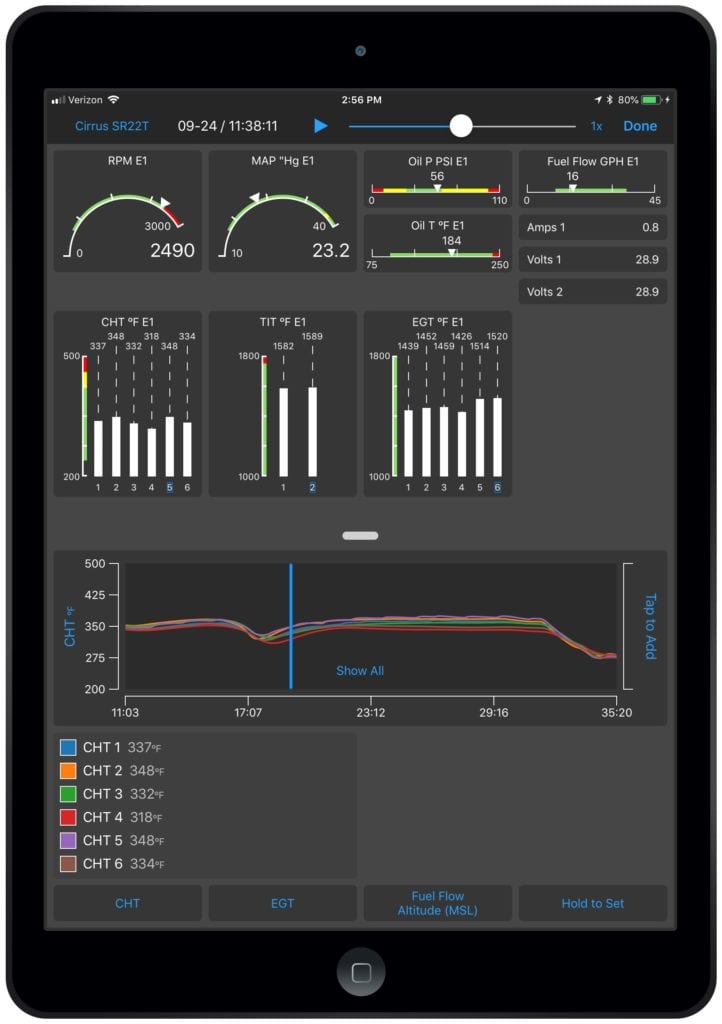Global Avionics Round-Up from Aircraft Value News (AVN)

Garmin Pilot engine monitoring on iOS. (Garmin)
In today’s data-driven world, the integration of avionics health monitoring systems with national infrastructure is transforming how aircraft fleets are managed and maintained. This evolution isn’t just improving safety; it’s also reshaping fleet economics and driving up aircraft values.
The crux of the issue is real-time connectivity. Traditionally, aircraft health monitoring was largely reactive. Pilots or maintenance crews would identify problems after flights or during scheduled inspections.
However, with modern avionics health monitoring systems, enhanced by broadband satellite links, edge computing, and artificial intelligence diagnostics, aircraft can now report performance anomalies and component degradations as they happen. By syncing these insights with national-level digital infrastructure, aviation authorities and operators gain instant, fleet-wide visibility.
From Silos to Systems
Historically, maintenance and monitoring data remained siloed within individual airline IT systems or aircraft OEM databases. But governments and aviation regulators, recognizing the safety and security benefits, are pushing toward the integration of aircraft health data into broader, nationally coordinated platforms. This model enables centralized oversight, rapid risk detection, and more informed regulatory interventions.
The U.S. FAA’s push toward NextGen infrastructure and Europe’s SESAR initiative are early examples of this alignment. These programs envision a future where aircraft are not only tracked geographically but also continuously assessed for systems integrity in real time. Through partnerships with airlines, OEMs, and software providers, national infrastructures are starting to ingest and analyze avionics data, offering benefits that ripple across every stakeholder in aviation.
Impacts on Aircraft Values
For aircraft appraisers and lessors, this integration has profound implications. Aircraft equipped with advanced avionics health monitoring capabilities, and proven to be connected to real-time data systems, are increasingly viewed as lower-risk assets. Their maintenance records are more transparent, their downtime is minimized, and their operational histories are traceable in ways that older, analog aircraft simply can’t match.
This transparency boosts residual values. Leasing companies can justify higher lease rates for aircraft with continuous health monitoring because these jets offer reduced likelihood of unscheduled maintenance and longer time-on-wing for key components. Operators can also extract more cycles before overhaul, further enhancing lifecycle economics.
Real-time avionics health monitoring also helps optimize fuel efficiency and reduce emissions, factors that enhance both environmental credibility and financial appeal.
A Catalyst for New Aviation Norms
This shift fosters new business models. Maintenance, Repair, and Overhaul (MRO) providers are moving toward “predictive maintenance-as-a-service” agreements. Airlines no longer wait for a fault; instead, they rely on ground-based analytics systems to schedule interventions before failures occur. This predictive capability is only possible through robust data integration with national infrastructure.
Meanwhile, insurance companies are beginning to recalibrate their risk models based on an aircraft’s real-time diagnostic capabilities. Just as the automotive world saw with telematics, aircraft with richer data trails are commanding more favorable terms.
For OEMs, the integration trend offers both opportunity and pressure. Manufacturers that can offer aircraft pre-integrated into national fleet oversight networks will have a competitive advantage. However, it also means they must open up more of their proprietary systems for third-party and regulatory access, an ongoing point of tension.
Challenges and Roadblocks
The transition isn’t without friction. Cybersecurity looms large. Connecting aircraft systems with national networks introduces vulnerabilities that must be aggressively mitigated. The global nature of aviation complicates standardization. Different nations operate on varying regulatory frameworks, data privacy laws, and infrastructure readiness levels.
For developing countries, the cost of upgrading national infrastructure to support integrated health monitoring remains a hurdle. However, with the rise of cloud-native platforms and scalable satellite connectivity, these barriers are gradually being lowered.
A New Global Baseline
As fleet-wide oversight becomes not just a capability but an expectation, aircraft without integrated avionics health monitoring systems may face depreciation. They’ll likely incur higher insurance costs, experience more downtime, and become less attractive to lessors and buyers. In effect, these aircraft are slowly being rendered obsolete by digital transformation.
Conversely, aircraft that are “born digital” and ready to plug into national oversight systems represent a new premium class of asset. In a future where real-time airworthiness data is accessible by both operators and regulators, transparency becomes currency and data becomes a determinant of value.
Final Descent
The integration of avionics health monitoring with national infrastructure isn’t just a technical upgrade; it’s a paradigm shift. It enhances safety, streamlines maintenance, and reshapes how aircraft are valued and financed. As this real-time connectivity becomes embedded into global aviation norms, stakeholders who embrace the change stand to gain, not just in efficiency and compliance but also in asset longevity and profitability.
This article also appeared in our partner publication, Aircraft Value News.
John Persinos is the editor-in-chief of Aircraft Value News.